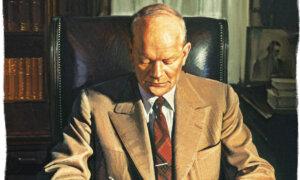Dwight Eisenhower (1890–1969) had been a major for 16 years, but he was an ambitious man. In 1936, he was promoted to permanent lieutenant colonel, after commanding a combat regiment. Seven years later, in 1943, Eisenhower was a full general and in 1944 was made supreme commander the Allied Expeditionary Forces. He led Allied forces to victory over the Nazi Germany and later became president. It was a meteoric rise, seemingly from out of nowhere.
“Becoming Eisenhower: How Ike Rose from Obscurity to Supreme Allied Commander” by Michael Lee Lanning follows Eisenhower’s career from 1915 to 1942, examining his preparation for success as supreme commander. The author looks at how Eisenhower got there, looking at his various postings before becoming commander of U.S. forces in Europe.
During his formative years in Abilene, Kansas, Lanning shows how Eisenhower’s parents and schooling shaped his character and work ethic. Ambitious for a college education, but unable to afford it, Eisenhower went to a service academy. West Point provided a free college education in exchange for service as a U.S. Army officer.
Once commissioned, Eisenhower discovered he liked the Army. He shows Eisenhower’s exasperation at being more valued as a football coach than as a combat officer, an administrator, or an officer trainer.
Lanning also shows Eisenhower’s frustration at not seeing combat during World War I. The years between the two world wars, including Eisenhower’s years as a major, offered varied and important experiences.

Preparation for Leadership
These experiences prepared him for high command. He helped develop an armor doctrine in WWI and earned a private pilot’s license while in the Philippines. Both gave him insights into mobile warfare and airpower that traditional infantry officers of the period lacked. His coaching experience showed how to develop teamwork and how to get disparate personalities to work together.His years on staff, preparing operations plans, gave him a deeper understanding of planning and logistics than those commanding battalions and regiments at similar points in their careers. Working directly under Gens. Fox Connor, John Pershing, Douglas McArthur, and George Marshall—who provided good and bad examples of leadership styles—prepared him for strategic command. Eisenhower was uniquely qualified for supreme command.
“Becoming Eisenhower” explores a neglected part of Eisenhower’s life. It reveals, as in so many cases, that becoming an “overnight success” requires decades of work and preparation.
Military history buffs, those interested in U.S. presidents, and those wondering what qualities define successful leaders will enjoy and benefit from Eisenhower’s life story during this critical period of his life.

by Michael Lee Lanning.







